Overview of Oracle Installed Base
This chapter covers the following topics:
- Definition of Oracle Installed Base
- Oracle Applications That Use Oracle Installed Base
- Examples of Transactions That Use Oracle Installed Base
Definition of Oracle Installed Base
Oracle Installed Base is an item instance life cycle tracking application that facilitates enterprise-wide (internal) life cycle item management and tracking capability. In addition, you can track customer (external) item instances.
Basic Tracking
You specify which items you want to track in the Master Item list in Oracle Inventory. Subsequently, when a particular real-world instance of the item is created, an item instance record is created in Oracle Installed Base. Any significant changes to the item instance will also be recorded in Oracle Installed Base.
![]()
Terminology
Tangible Items
Item instances can be used to track tangible items that can be assembled and shipped, such as computers, engines, machine parts, and so on.
Intangible Items
Item instances can be used to track intangible items such as software, services, licenses, and agreements. For example, a telephone number can have different services such as call waiting and conference call. These can all be defined and tracked as components of the telephone service.
Serialized Items
When a trackable item is defined in Oracle Inventory as serialized, each item instance derived from that item requires a unique serial number and individual tracking. The item instance will always have a quantity of 1.
Non-Serialized Items
When a trackable item is defined in Oracle Inventory as non-serialized, it is typically for smaller objects whose real-world instances do not require individual tracking. For example, a screw could be defined as a non-serialized, trackable item; an order for 100 screws would result, after order shipping, in the creation of one item instance, with a quantity of 100.
See also Serialization and Levels of Tracking.
Item Instance Movement Tracking
Oracle Installed Base can track an item instance from the time that it is received in inventory, in work in process, in projects, at customer sites, and throughout the return and repair process.
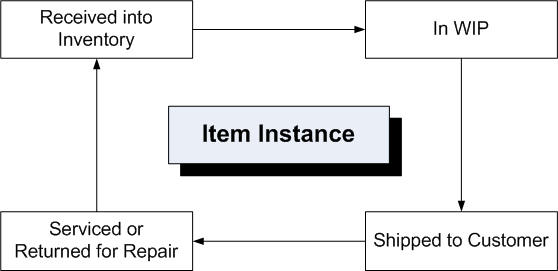
Item Instance Attribute Change Tracking
Oracle Installed Base is a centralized repository of information for an item instance and its tracking details including location, status, ownership, party role, and contact relationships. It also supports the creation and maintenance of Oracle Installed Base configurations.
Counters can be tied to item instances so that usage can be captured. For example, if an item instance is an electrical meter, then counters can be used to store the meter reading, thus recording the usage that in turn generates revenue.
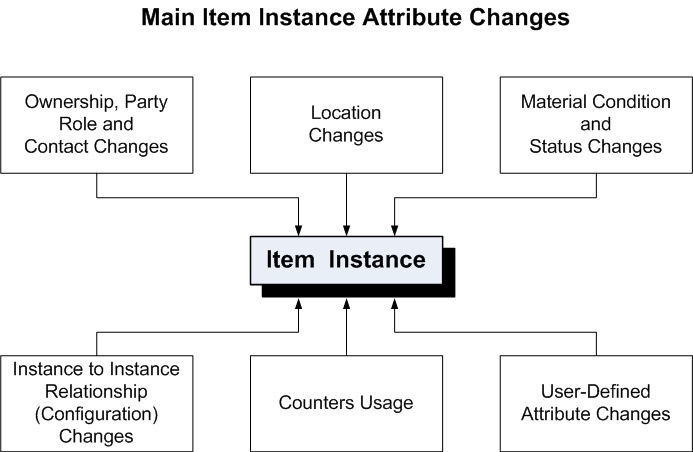
History of Item Instance Changes
Oracle Installed Base records a history of changes to item instances.
For each item instance in Oracle Installed Base, a history of transactions is tracked and stored. You can view the transactions and the attribute state for a particular time frame.
The transaction history includes a list of inventory, work in process, order management, and other transactions affecting an item's tracking attributes.

Objects Related to Item Instances
Oracle Installed Base provides links to detailed information on service contracts, customer warranties, service requests, work requests, and service orders associated to item instances. To provide this information, Oracle Installed Base interfaces with other Oracle applications, which include Oracle TeleService, Oracle Service Contracts, Oracle Enterprise Asset Management, Oracle Order Management, and Oracle Depot Repair.
Serialization and Levels of Tracking
The extent of the tracking that Oracle Installed Base performs for an item depends on its serialization setup. The levels of tracking, with the highest tracking level first, are as follows:
-
Items that are serialized at receipt or have predefined serialization.
-
Items that are serialized at sales order issue.
-
Non-serialized items.
If an item is serialized at receipt, Oracle Installed Base begins tracking all the significant changes that affect an item instance before it is sent out to a customer. For items serialized at sales order issue, tracking starts at the time of sale order issue, and records all transactions that occur at the customer site.
Non-serialized items can be tracked only as a group, where the quantity of items in the group may be 1, but is typically a larger number.
For non-serialized items, there are transactions where only part of the group is processed, such as partial returns on RMA receipts and cancellations. In these transactions, Oracle Installed Base splits the original item instance into two. For example, when a customer returns part of a group of non-serialized items, the original item instance records the quantity that remains with the customer, and the second item instance records the quantity being returned.
There are also transactions where Oracle Installed Base merges item instances, such as when non-serialized items are returned into inventory.
Oracle Applications That Use Oracle Installed Base
The Oracle applications that use Oracle Installed Base are:
-
Asset Tracking
-
Assets
-
Complex Maintenance Repair and Overhaul
-
Configurator
-
Depot Repair
-
Enterprise Asset Management
-
Field Service
-
Inventory
-
Lease Management
-
Order Capture
-
Order Management
-
Process Manufacturing
-
Project Contracts
-
Provisioning
-
Purchasing
-
Quoting
-
Service Contracts
-
Site Hub
-
TeleService
-
Utility Billing
-
Work in Process

A list of the Oracle transactions that interface with Oracle Installed Base appears in Oracle Transactions Interfacing with Oracle Installed Base, together with the Oracle application that triggers each transaction.
Examples of Transactions That Use Oracle Installed Base
Several Oracle Order Management transactions interact with Oracle Inventory and Oracle Installed Base.
Purchase Orders
The following diagram shows the high-level flow for purchase orders.
Purchase Order Processing Flow
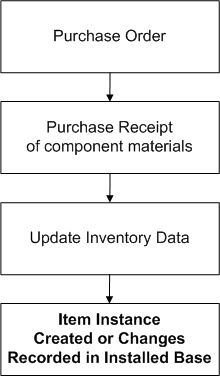
The receipt of the component materials on the purchase order is recorded by Oracle Inventory, and Oracle Installed Base starts to track the item instances.
Item Assembly
The following diagram shows the high-level flow for item assembly.
Item Assembly Processing Flow
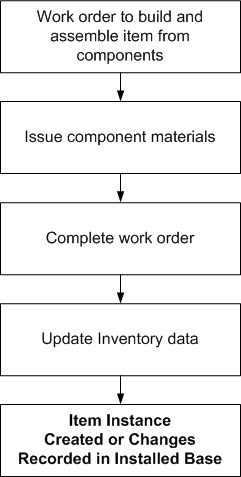
The main processing associated with the building and assembly of items occurs in Oracle Work in Process. When all components have been completed and the item is assembled, this is recorded both in Oracle Inventory and Oracle Installed Base.
Shipped and Fulfilled Order Lines
The following diagram shows the high-level flow for shippable and non-shippable items on sales orders.
Order Processing Flow

A sales order shipment generates an Inventory Issue material transaction in the Oracle Inventory application. Because Oracle Installed Base also tracks the internal inventory for trackable items, the instance already exists in Oracle Installed Base. A shipment can result in a change in instance location and ownership, status, and so on, based on the associated Oracle Installed Base transaction subtype.
Oracle Installed Base tracking of non-shippable items at fulfillment requires the workflow configuration as defined in the Oracle Installed Base Implementation Guide.
Material Returns
The following diagram shows the high-level flow for material returns.
Material Return Processing Flow
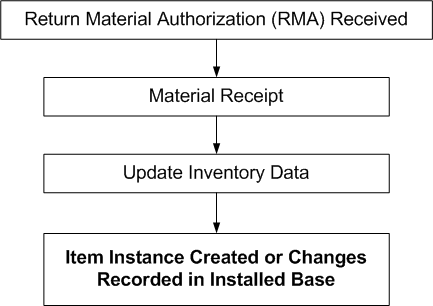
A sales order return line provides for an Oracle Inventory receipt material transaction in the Oracle Inventory application. Because the Oracle Installed Base instance already exists for the item being returned, a receipt can trigger an update of the specified instance, depending on the Oracle Installed Base transaction type being used.
Oracle Installed Base also supports the Oracle Order Management RMA fulfillment process for non-shippable items subject to rules and conditions defined in the Oracle Installed Base Implementation Guide.